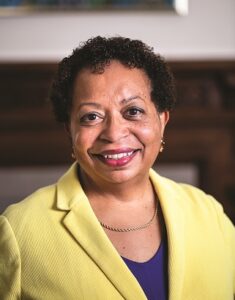Creating a curriculum with tomorrow in mind

The auditorium in McCook was packed. Some faculty members stood along the edges of the room, and others perched on the steps at the ends of the rows. Faculty meetings aren’t always so well attended, but this one in November was especially important, and professors from all parts of the college and at all stages of their careers turned out. The occasion: a vote on the first major revision to Trinity’s curriculum in more than a decade.
To those outside of higher education, this might not seem like a big deal. But to those on the inside, especially faculty, the curriculum defines the educational experience we promise and reflects our values and our identity as an institution. The curriculum is at the very core of our mission as an educational institution. A curriculum’s strength is in its rigor, its depth and breadth, and its relevance to the world. That last part—relevance—was at the heart of the endeavor our faculty has undertaken over the past two years: to contemplate the curriculum in the context of the 21st century.
The work of the faculty, led by the Curriculum Committee (whose members are faculty, administrators, and students), culminated in a proposal thoroughly considered and eventually brought to the floor of the faculty meeting on November 12. The proposal sought to revise the curriculum to include 32 core academic credits; three additional credits known as the Trinity Plus, which can include co-curricular experiences and the option of an experiential certificate (for example, highlighting internships, summer research, and short-term study); and a wellness requirement, intended to promote personal well-being. Also new: students who achieve a 3.667 grade-point average in two majors from different divisions would be able to earn a new distinction upon graduation, Honors in Liberal Arts.
The faculty voted overwhelmingly (126 in favor, 6 opposed, and 3 abstentions) to approve the new curriculum. It was a model of effective collaboration among faculty, administrators, and students, most especially faculty. The new curriculum, which will be effective for the Class of 2025, is distinctive and forward-looking. It reinforces our core liberal arts academic mission and prepares students for the future by building a bridge to life after college.
I cannot stress enough to our alumni and parent readers how meaningful this moment is in the life of the college. As an institution of higher learning, we have a responsibility to develop citizens who think critically, embrace complexity, and engage across differences in building a free and just society. At the same time, our identity as a small, residential liberal arts college in a New England state capital allows us to provide a distinctive, rigorous education that gives students the perspectives, knowledge, and skills to advance society. That dual sense of responsibility and opportunity was the spirit with which our faculty took up the work to achieve two of the main objectives of Summit, Trinity’s strategic plan: to “connect the curriculum more fully to the college’s mission, including its valuing of guided self-reflection and experiential learning, articulating clearly what defines a Trinity liberal arts education” and to “prepare students for success inside and outside the classroom in a dynamically changing world.”
I could not be more pleased by nor prouder of Trinity’s outstanding faculty. As the new curriculum now moves to implementation, many details remain to be worked out, of course. And I believe the faculty see this vote as a big first step toward continued evolution of our distinctive Trinity educational experience. All of us who love Trinity have a role to play in its future. Faculty members, in this case, see one of their primary roles quite rightly as stewards of the curriculum, responsible for attending to it today and for ensuring its strength for generations to come.
